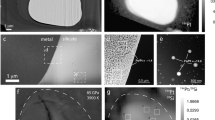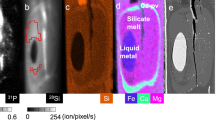Abstract
The high-pressure solubility in silicate liquids of moderately siderophile ‘iron-loving’ elements (such as nickel and cobalt) has been used to suggest that, in the early Earth, an equilibrium between core-forming metals and the silicate mantle was established at the bottom of a magma ocean1,2. But observed concentrations of the highly siderophile elements—such as the platinum-group elements platinum, palladium, rhenium, iridium, ruthenium and osmium—in the Earth's upper mantle can be explained by such a model only if their metal–silicate partition coefficients at high pressure are orders of magnitude lower than those determined experimentally at one atmosphere (refs 3,4,5,6,7,8). Here we present an experimental determination of the solubility of palladium and platinum in silicate melts as a function of pressure to 16 GPa (corresponding to about 500 km depth in the Earth). We find that both the palladium and platinum metal–silicate partition coefficients, derived from solubility, do not decrease with pressure—that is, palladium and platinum retain a strong preference for the metal phase even at high pressures. Consequently the observed abundances of palladium and platinum in the upper mantle seem to be best explained by a ‘late veneer’ addition of chondritic material to the upper mantle following the cessation of core formation.
This is a preview of subscription content, access via your institution
Access options
Subscribe to this journal
Receive 51 print issues and online access
$199.00 per year
only $3.90 per issue
Buy this article
- Purchase on Springer Link
- Instant access to full article PDF
Prices may be subject to local taxes which are calculated during checkout

Similar content being viewed by others
References
Li, J. & Agee, C. B. Geochemistry of mantle-core differentiation at high pressure. Nature 381, 686– 689 (1996).
Righter, K. & Drake, M. J. Metal-silicate equilibrium in a homogeneously accreting Earth: new results for Re. Earth Planet. Sci. Lett. 146, 541–553 (1997).
Borisov, A., Palme, H. & Spettel, B. Solubility of palladium in silicate melts: implications for core formation in the Earth. Geochim. Cosmochim. Acta 58, 705–716 (1994).
Borisov, A. & Palme, H. Experimental determination of the solubility of platinum in silicate melts. Geochim. Cosmochim. Acta 61, 4349–4357 ( 1997).
Ertel, W. et al. Solubilities of platinum and rhodium in a haplobasaltic melt at 1300°C. Geochim. Cosmochim. Acta 63, 2439–2449 (1999).
Borisov, A. & Palme, H. The solubility of iridium in silicate melts: new data from experiments with Ir10Pt90 alloys. Geochim. Cosmochim. Acta 59, 481– 485 (1995).
Borisov, A. & Palme, H. Noble metal/silicate melt equilibria: experimental investigations and geochemical implications. Eur. J. Mineral. 9 (Suppl.), 59 (1997 ).
O'Neill, H. St C. et al. Experimental petrochemistry of some highly siderophile elements at high temperatures, and some implications for core formation and the mantle's early history. Chem. Geol. 120, 255–273 (1995).
O'Neill, H. St C. & Palme, H. in The Earth's Mantle, Composition, Structure and Evolution (ed. Jackson, I.), 3– 126 (Cambridge Univ. Press, Cambridge, 1998).
Murthy, V. R. Early differentiation of the Earth and the problem of mantle siderophile elements: a new approach. Science 253, 303–306 (1991); corrections 253, 1467 ( 1991).
Walter, M. Screws tighten on the core. Nature 398, 563–565 (1999).
Ringwood, A. E. The Earth's core: its composition, formation and bearing upon the origin of the Earth. Proc. R. Soc. Lond. A 395, 1– 46 (1984).
Wänke, H., Dreibus, G. & Jagoutz, E. in Archean Geochemistry (ed. Kröner, A.) 1–24 (Springer, Berlin, 1984).
O'Neill, H. St C. The origin of the Moon and the early history of the Earth—a chemical model. Part 2: The Earth. Geochim. Cosmochim. Acta 55, 1159–1172 (1991).
Walter, M. At the magma ocean floor. Nature 381, 646 –647 (1996).
Morgan, J. W., Wandless, G. A., Petrie, R. K. & Irving, A. J. Composition of the Earth's upper mantle-I. Siderophile trace elements in ultramafic nodules. Tectonophysics 75, 47– 67 (1981).
Jagoutz, E. et al. The abundances of major, minor and trace elements in the Earth's mantle as derived from primitive ultramafic nodules. Proc. Lunar Planet. Sci. Conf. 10, 2031–2050 (1979).
Morgan, J. W. Ultramafic xenoliths: clues to Earth's late accretionary history. J. Geophys. Res. 91, 12375–12387 (1986).
Kimura, K., Lewis, R. S. & Anders, E. Distribution of gold and rhenium between nickel-iron and silicate melts: implications for the abundances of siderophile elements on the Earth and Moon. Geochim. Cosmochim. Acta 38, 683–701 (1974).
Holzheid, A., Palme, H. & Chakraborty, S. The activities of NiO, CoO and FeO in silicate melts. Chem. Geol. 139, 21–38 (1997).
Hultgren, R., Desai, P. D., Hawkins, D. T., Gleiser, M. & Kelley, K. K. Selected Values of the Thermodynamic Properties of Binary Alloys (American Society for Metals, Metals Park, Ohio, 1973).
Meisel, T., Walker, R. J. & Morgan, J. W. The osmium isotopic composition of the Earth's primitive upper mantle. Nature 383, 517– 520 (1996).
Hillgren, V. J., Drake, M. J. & Rubie, D. C. High-pressure and high-temperature experiments on core-mantle segregation in the accreting Earth. Science 264, 1442–1445 (1994).
Seckendorff, V. & O'Neill, H. St C. An experimental study of Fe-Mg partitioning between olivine and orthopyroxene at 1173, 1273, and 1423 K and 1.6 GPa. Contrib. Mineral. Petrol. 113 , 196–207 (1993).
Rubie, D. C., Karato, S., Yan, H. & O'Neill, H. St C. Low differential stress and controlled chemical environment in multi-anvil high pressure experiments. Phys. Chem. Miner. 20, 315– 322 (1993).
Sylvester, P. J. & Eggins, S. M. Analysis of Re, Au, Pt, Pd, and Rh in NIST glass certified reference materials and natural basalt glasses by laser ablation-ICP-MS. Geostand. Newsl. 21, 215–229 (1997).
Holzheid, A. & Palme, H. The influence of FeO on the solubilities of Co and Ni in silicate melts. Geochim. Cosmochim. Acta 60, 1181–1193 (1996).
Acknowledgements
High pressure experiments were performed at the Bayerisches Geoinstitut under the EU ‘TMR - Large Scale Facilities’ (D.C.R.) programme.
Author information
Authors and Affiliations
Corresponding author
Rights and permissions
About this article
Cite this article
Holzheid, A., Sylvester, P., O'Neill, H. et al. Evidence for a late chondritic veneer in the Earth's mantle from high-pressure partitioning of palladium and platinum. Nature 406, 396–399 (2000). https://doi.org/10.1038/35019050
Received:
Accepted:
Issue Date:
DOI: https://doi.org/10.1038/35019050
This article is cited by
-
Geochemical models of core–mantle differentiation
Acta Geochimica (2022)
-
Ariel – a window to the origin of life on early earth?
Experimental Astronomy (2022)
-
Platinum-group elements, S, Se and Cu in highly depleted abyssal peridotites from the Mid-Atlantic Ocean Ridge (ODP Hole 1274A): Influence of hydrothermal and magmatic processes
Contributions to Mineralogy and Petrology (2013)
-
Core Formation and Mantle Differentiation on Mars
Space Science Reviews (2013)
Comments
By submitting a comment you agree to abide by our Terms and Community Guidelines. If you find something abusive or that does not comply with our terms or guidelines please flag it as inappropriate.



